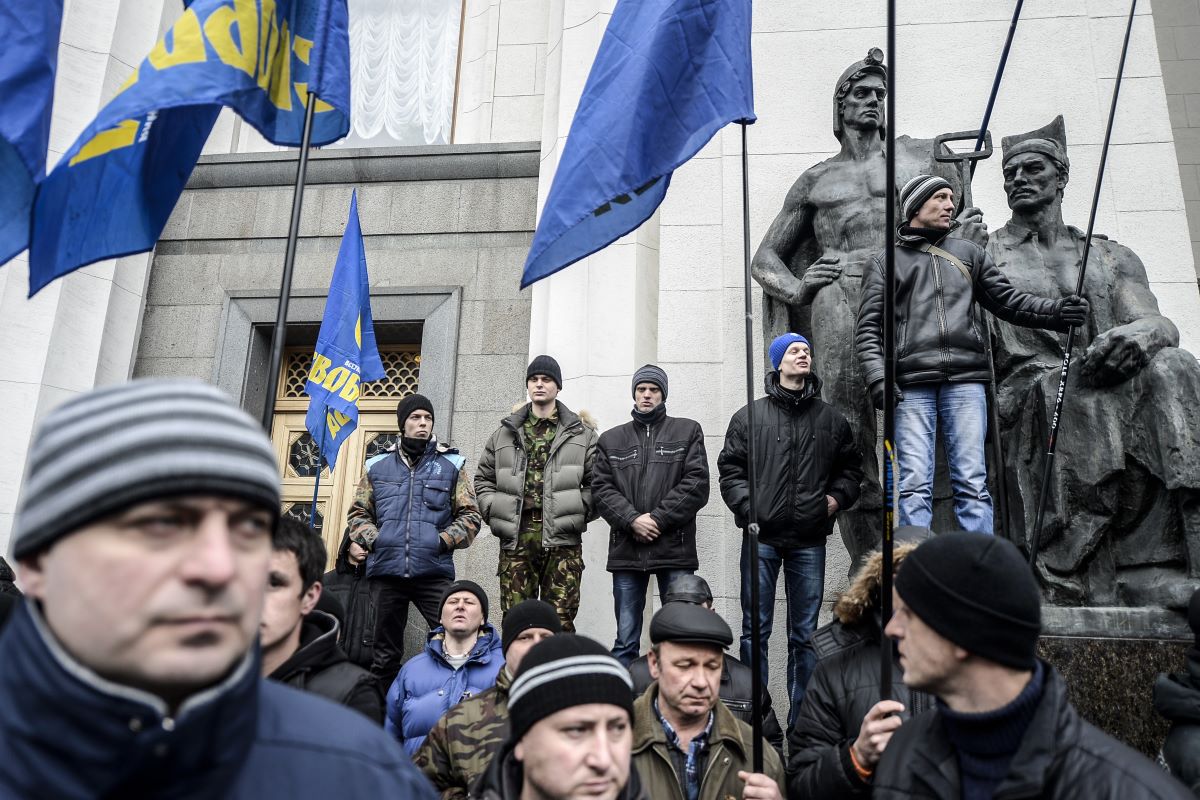Tokyo stocks retreat amid geopolitical, economic uncertainties
Tokyo stocks retreated on Wednesday as investors grappled with heightened uncertainties surrounding US monetary policy and geopolitical tensions between Ukraine and Russia.
The number 14, a reference to an American far-right mantra was also present, and Tarrant’s backpack sported a circular Norse rune known as the ‘sonnenrad’, or ‘black sun’. This symbol, one of many ancient European symbols appropriated by the Nazis, features prominently in contemporary neo-Nazi and far-right lore. It is also popping up regularly in Ukraine.

representational image/People wearing Svoboda party flags in Ukraine (AFP file photo)
On 19 March 2019, Brenton Tarrant, a 28-year-old white man from Australia murdered 51 Muslim worshippers in what is known as the Christchurch mosque massacre. Brenton was an avowed white supremacist who had previously expressed support for the Serbian military and militias responsible for carrying out atrocities against Bosnian Muslims.
The weapons he used to commit this atrocity were painted with white supremacist slogans, symbols and historical references that resonate with the far-right in Europe: ‘Vienna 1683’ referred to the Ottoman defeat at Kahlenburg, while ‘Acre 1189’ harks to the Crusades, an event of mythic importance for European racists.
The name of Charles Martel, the Frankish King who defeated the Arabs at the Battle of Tours was there, along with that of Pavlo Lapshyn, a Ukrainian extremist who killed Muhammad Saleem in Birmingham because he hated ‘non-whites’. The number 14, a reference to an American far-right mantra was also present, and Tarrant’s backpack sported a circular Norse rune known as the ‘sonnenrad’, or ‘black sun’. This symbol, one of many ancient European symbols appropriated by the Nazis, features prominently in contemporary neo-Nazi and far-right lore. It is also popping up regularly in Ukraine.
Advertisement
Recently, a picture uploaded by Nato’s official Twitter account on International Women’s Day showed a woman in combat gear sporting a sonnenrad symbol. The same symbol was seen on the uniform of a Ukrainian ‘serviceman’ in a picture uploaded by Getty’s images. Nexta TV, a Belarussian media outlet, that often finds itself on the wrong side of the country’s pro-Russian regime, posted pictures of members of the Ukrainian Azov regiment receiving advanced grenade launchers and training from “instructors from Nato countries”.
All these fighters sported the logo of the Azov battalion. This logo, known as the ‘Wolfangel’, is another ancient Norse rune that was appropriated by Nazi Germany and appeared on the insignia of several Waffen-SS regiments. How it came to be adopted by the far-right, ultra-nationalist Azov regiment currently one of the best trained and armed groups fighting Russia in Ukraine involves a primer on Ukraine’s history.
When Germany invaded the USSR in World War II, they received considerable support from elements in western Ukraine who initially saw the Germans as liberators who would help Ukraine throw off the yoke of Soviet rule. Prominent among these was Stepan Bandera, who pledged allegiance to Nazi Germany but later turned against their policies when it became clear that the Germans were less interested in liberating Ukraine than in turning that fertile land into a breadbasket for Germany, operated by Ukrainian serfs.
However, even when Bandera himself was in a Nazi concentration camp, his Order of Ukrainian Nationalists continued to carry out massacres of Poles and Jews while also targeting political opponents. Bandera may be a divisive figure in Ukraine today, but to the Azov regiment he is a hero; after all, Bandera was a proponent of selective breeding to create a ‘pure’ Ukrainian race and the founder of the Azov regiment. Andriy Biletsky is on record as saying in 2010 that Ukraine’s destiny was to “lead the white races of the world in a final crusade … against Semite-led Untermenschen [inferior races]”.
The Azov battalion began as a volunteer militia in 2014, fighting pro-Russian separatists in Donetsk in eastern Ukraine. Since then, they have been adopted by Ukraine’s armed forces and have become more politically active, while also forging closer links with far-right groups and militias across the Western world. This is where things start to get dangerous; it is a fact that adherents of far-right and neo-Nazi ideologies in the West seek out former and serving police and military personnel to join their networks.
With a flood of ‘volunteers’ from across the West joining the fight in Ukraine sometimes with active encouragement from their governments, it is a certainty that militant neo-Nazis are also heeding the call and travelling to Ukraine not just to forge deeper links with transnational white supremacist movements but to also gain battlefield experience which can then be used to prosecute their domestic wars against minorities and political opponents.
In the murky online world of these radicals, not only are ideas and tactics exchanged but active efforts are being made on forums and chat groups to coordinate travel and border crossings to make it easier for latter-day Nazis keen on joining the battle to get to Ukraine. If this sounds familiar, that’s because what is unfolding in Ukraine today bears close parallels to the influx of fighters in the Afghan wars and also in the Syrian civil war. If the Ukraine war drags on into insurgency and urban warfare, we may well find that it was to international Nazis what the Afghan and Syrian conflicts were to international jihadis.
(Dawn/ANN.)
Advertisement